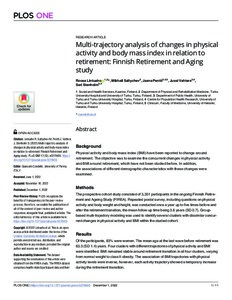Multi-trajectory analysis of changes in physical activity and body mass index in relation to retirement: Finnish Retirement and Aging study
Lintuaho Roosa; Saltychev Mikhail; Pentti Jaana; Vahtera Jussi; Stenholm Sari
https://urn.fi/URN:NBN:fi-fe2022121571609
Tiivistelmä
Background: Physical activity and body mass index (BMI) have been reported to change around retirement. The objective was to examine the concurrent changes in physical activity and BMI around retirement, which have not been studied before. In addition, the associations of different demographic characteristics with these changes were examined.
Methods: The prospective cohort study consisted of 3,351 participants in the ongoing Finnish Retirement and Ageing Study (FIREA). Repeated postal survey, including questions on physical activity and body weight and height, was conducted once a year up to five times before and after the retirement transition, the mean follow-up time being 3.6 years (SD 0.7). Group-based multi-trajectory modeling was used to identify several clusters with dissimilar concurrent changes in physical activity and BMI within the studied cohort.
Results: Of the participants, 83% were women. The mean age at the last wave before retirement was 63.3 (SD 1.4) years. Four clusters with different trajectories of physical activity and BMI were identified. BMI remained stable around retirement transition in all four clusters, varying from normal weight to class II obesity. The association of BMI trajectories with physical activity levels were inverse, however, each activity trajectory showed a temporary increase during the retirement transition.
Conclusions: Retirement seems to have more effect on physical activity than BMI, showing a temporary increase in physical activity at the time of retirement.
Kokoelmat
- Rinnakkaistallenteet [27094]
